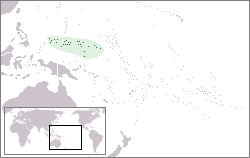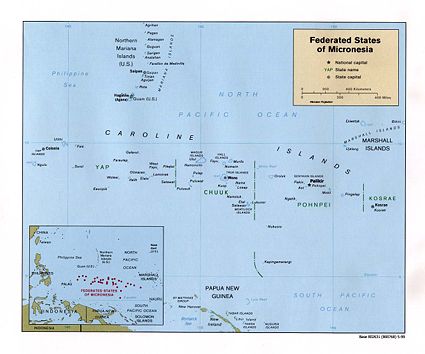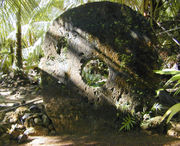Federated States of Micronesia
2008/9 Schools Wikipedia Selection. Related subjects: Geography of Oceania (Australasia)
| Federated States of Micronesia | ||||||
|---|---|---|---|---|---|---|
|
||||||
| Motto: Peace Unity Liberty | ||||||
| Anthem: Patriots of Micronesia |
||||||
|
|
||||||
| Capital | Palikir |
|||||
| Largest city | Weno | |||||
| Official languages | English (national; local languages are used at state and municipal levels) | |||||
| Demonym | Micronesian | |||||
| Government | Democratic Federated Presidential Republic | |||||
| - | President | Manny Mori | ||||
| - | Vice President | Alik L. Alik | ||||
| Independence | from US-administered UN Trusteeship | |||||
| - | Date | 3 November 1986 | ||||
| Area | ||||||
| - | Total | 702 km² ( 188th) 271 sq mi |
||||
| - | Water (%) | negligible | ||||
| Population | ||||||
| - | July 2007 estimate | 107,862 ( 181st) | ||||
| - | 2000 census | 107,000 | ||||
| - | Density | 154/km² ( 66th) 399/sq mi |
||||
| GDP ( PPP) | 2002 estimate | |||||
| - | Total | $277 million² ( 215th) | ||||
| - | Per capita | $2,000 ( 180th) | ||||
| HDI (2003) | n/a (unranked) ( n/a) | |||||
| Currency | United States dollar ( USD) |
|||||
| Time zone | ( UTC+10 and +11) | |||||
| - | Summer ( DST) | not observed ( UTC+10 and +11) | ||||
| Internet TLD | .fm | |||||
| Calling code | +691 | |||||
| 1 | GDP is supplemented by grant aid, averaging around $100 million annually (2002 estimate). | |||||
| 2 | 2002 estimate. | |||||
The Federated States of Micronesia is an island nation located in the Pacific Ocean, northeast of Papua New Guinea. The country is a sovereign state in free association with the United States. The Federated States of Micronesia were formerly part of the Trust Territory of the Pacific Islands, a United Nations Trust Territory under US administration. In 1979 they adopted a constitution, and in 1986 independence was attained under a Compact of Free Association with the United States. Present concerns include large-scale unemployment, overfishing, and dependence on U.S. aid.
The Federated States of Micronesia are located in the region known as Micronesia, which consists of hundreds of small islands divided in seven territories. The term Micronesia may refer to the Federated States or to the region as a whole, even though the lack of a central government makes it a sovereign group of states, not a country.
History
The ancestors of the Micronesians settled over four thousand years ago. A decentralized chieftain-based system eventually evolved into a more centralized economic and religious empire centered on Yap.
Nan Madol, consisting of a series of small artificial islands linked by a network of canals, is often called the Venice of the Pacific. It is located near the island of Pohnpei and used to be the ceremonial and political seat of the Saudeleur dynasty that united Pohnpei's estimated 25,000 people from about AD 500 until 1500, when the centralized system collapsed.
European explorers — first the Portuguese in search of the Spice Islands (Indonesia) and then the Spanish — reached the Carolines in the sixteenth century, with the Spanish establishing sovereignty. It was sold to Germany in 1899, conquered by Japan in 1914, before being seized by the United States during World War II and administered by the US under United Nations auspices in 1947 as part of the Trust Territory of the Pacific Islands.
During World War II, a significant portion of the Japanese fleet was based in Truk Lagoon. In February 1944, Operation Hailstone, one of the most important naval battles of the war, took place at Truk, in which many Japanese support vessels and aircraft were destroyed.
On May 10, 1979, four of the Trust Territory districts ratified a new constitution to become the Federated States of Micronesia. Palau, the Marshall Islands, and the Northern Mariana Islands chose not to participate. The FSM signed a Compact of Free Association with the United States of America, which entered into force on November 3, 1986, marking Micronesia's emergence from trusteeship to independence.
Politics
The Federated States of Micronesia are governed by the 1979 constitution, which guarantees fundamental human rights and establishes a separation of governmental powers. The unicameral Congress has fourteen members elected by popular vote. Four senators — one from each state — serve four-year terms; the remaining ten senators represent single-member districts based on population, and serve two-year terms. The President and Vice President are elected by Congress from among the four state-based senators to serve four-year terms in the executive branch. Their congressional seats are then filled by special elections. The president and vice president are supported by an appointed cabinet. There are no formal political parties.
In international politics, the Federated States of Micronesia has always voted on the side of the United States with respect to United Nations General Assembly resolutions.
Administrative divisions
The four states in the federation are:
These states are further divided into municipalities.
Geography
The Federated States of Micronesia consists of 607 islands extending 1,800 miles (2,900 km) (2,900 km) across the archipelago of the Caroline Islands east of the Philippines. The four constituent island groups are Yap, Chuuk (called Truk until January 1990), Pohnpei (known as "Ponape" until November 1984), and Kosrae (formerly Kusiae). These four states are each represented by a white star on the national flag. The capital is Palikir, on Pohnpei.
The country has seven official languages: English, Ulithian, Woleaian, Yapese, Pohnpeian, Kosraean, and Chuukese.
The other languages spoken in Micronesia are Pingelapese, Ngatikese, Satawalese, Kapingamarangi Language, Nukuoro Language, Puluwatese, and Mokilese.
Economy
Economic activity of the Federated States of Micronesia consists primarily of subsistence farming and fishing. The islands have few mineral deposits worth exploiting, except for high-grade phosphate. Long line tuna fishing is also viable with foreign vessels from Taiwan and China operated in the 1990s. The potential for a tourist industry exists, but the remoteness of the location and a lack of adequate facilities hinder development. Financial assistance from the US is the primary source of revenue, with the US pledged to spend $1.3 billion in the islands in 1986-2001. Geographical isolation and a poorly developed infrastructure are major impediments to long-term growth.
The nation uses the US dollar as their currency.
Demographics
The indigenous population of the Federated States of Micronesia, which is predominantly Micronesian, consists of various ethnolinguistic groups. It has a nearly 100% Pacific Islander and Asian population. Chuukese 48.8%, Pohnpeian 24.2%, Kosraean 6.2%, Yapese 5.2%, Yap outer islands 4.5%, Asian 1.8%, Polynesian 1.5%, other 6.4%, unknown 1.4%. Many Micronesians are known to have some Japanese ancestry, which is a result of intermarriages between Japanese settlers and Micronesians during the Japanese colonial period.
There is a growing population of Americans, Australians, Europeans, and residents from China and the Philippines. English has become the common language of the government, and for secondary and tertiary education. Outside of the main capital towns of the four FSM states, the local languages are primarily spoken. Population growth remains high at more than 3% annually, offset somewhat by net emigration.
Pohnpei is notable for the prevalence of the extreme form of colour blindness known as maskun.
Culture
Each of the four States has its own culture and traditions, but there are also common cultural and economic bonds that are centuries old. For example, cultural similarities like the importance of the traditional extended family and clan systems can be found on all the islands.
The island of Yap is notable for its "stone money" ( Rai stones), large disks usually of calcite, up to 12 feet (4 m) in diameter, with a hole in the middle. The islanders, aware of the owner of a piece, do not necessarily move them when ownership changes. There are five major types: Mmbul, Gaw, Ray, Yar, and Reng, the last being only 1 foot (0.3 m) in diameter. Their value is based on both size and history, many of them having been brought from other islands, as far as New Guinea, but most coming in ancient times from Palau. Approximately 6,500 of them are scattered around the island.
Defense arrangements
The FSM is a sovereign, self-governing state in free association with the United States, which is wholly responsible for its defense. The Division of Maritime Surveillance operates a paramilitary Maritime Wing and a small Maritime Police Unit.
The Compact of Free Association allows FSM citizens to join the US military without having to obtain U.S. permanent residency or citizenship.




